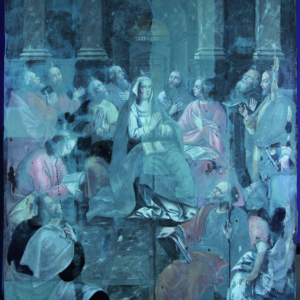Unknown Artist, Descent of the Holy Spirit
IR images show painting without traces of underdrawing along with undisturbed surface but also portions very desrtroyed
The Descent of the Holy Spirit, early 17th century
The accidentally damaged painting on a wooden oak panel found in the Czech border region of the former Sudetenland is completely “without a past”. Despite the undeniable quality of the painting, its classification, dating and provenance are very problematic. It is most likely based on the Saxon tradition of 16th century panel painting. The palette of pigments is late Gothic or Renaissance. It includes minium, vermilion, various varieties of copper pigments, smalt, azurite and probably lead-tin yellow.
The image is an iconographic theme of the “Descent of the Holy Spirit” which is a standard part of Christological and Marian cycles. At Pentecost, the Holy Spirit descended on the Apostles and the Virgin Mary in the form of clemens, so that from then on they could speak in different languages and spread the Gospel among all nations (PhDr. Kateřina Mazačová). The work is an adept for a closer artistic and scientific analysis.
The painting bears a number of historical overpaintings, and thanks to the old, high-quality and solid oak auxiliary cradle, it has survived leaks and problematic storage for decades. The restoration addressed flaking and significantly loose areas of the painting, along with the removal of yellowed varnish and overpaintings. The major earlier painting restorations were merely improved without any ambition to fully redo all the previous repairs.









